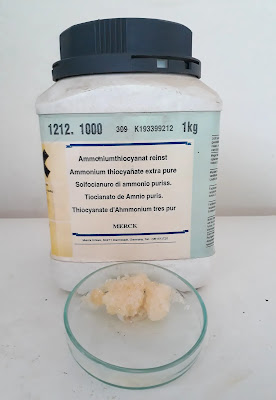Product Identification
- Read – Ammonium Thiocyanate SDS!
Hazards
- Skin & eye irritation: On contact, ammonium thiocyanate might cause minor skin & eye discomfort.
- Respiratory issues: Breathing in a lot of ammonium thiocyanate dust might make breathing difficult & make you cough and wheeze.
- Ingestion: Ammonium thiocyanate poisoning can result in diarrhea & upset stomach when consumed in excessive doses.
First-Aid Measures
- Skin contact: With water, thoroughly wash the afflicted area.
- Eye contact: For at least fifteen minutes, rinse your eyes with water.
- Inhalation: Get outside and into some fresh air.
- Ingestion: Take a sip of water.
Fire-Fighting Measures
- Extinguishing media: Isn’t flammable.
- Special hazards: None knew.
Self-contained breathing equipment & full protection gear should be worn by firefighters.
Handling & Storage
- Handling: Make use of sufficient ventilation & refrain from inhaling ammonium thiocyanate dust. Avoid making eye or skin contact.
- Storage: Store away from heat sources, sparks, & open flames in a place that is cold, dry, & well-ventilated. Maintain containers’ labels and tight seals.
Exposure Controls/Personal Protection
- Engineering controls: By utilising the proper ventilation, keep ammonium thiocyanate dust concentrations below the recommended exposure limit.
- Personal protective equipment: Put on a face shield, protective gloves, & eyewear. If required, wear a respirator.
Physical & Chemical properties
- Appearance: White, crystalline (powder)
- Odor: Odorless.
- Melting point: 260 °C.
- Density: 1.6 g/cm3.
- Solubility: Highly soluble in water.

An inorganic substance called ammonium thiocyanate (NH4SCN) is employed in a wide range of industrial & laboratory processes, such as a reagent in chemical analysis, a reducing agent, & an intermediate in the synthesis of other compounds. Although it is typically regarded as a drug that is quite harmless, if handled or used incorrectly, it can irritate & have other negative effects.
Conclusion
Ammonium thiocyanate is a chemical that has a variety of industrial and laboratory uses & is generally safe to use. However, if handled or utilized incorrectly, it can result in moderate irritability & other negative effects. When handling or working with ammonium thiocyanate, adequate safety measures, such as the use of personal protection equipment, suitable ventilation, & safe storage procedures, must be taken to avoid mishaps & injuries. In the event of unintentional exposure, first aid should be administered right away, and if symptoms persist, medical treatment should be sought.
Although ammonium thiocyanate is thought to be safe, it shouldn’t be ingested in high amounts because it can lead to diarrhea & upset stomach. Additionally, when working with ammonium thiocyanate, it should be handled carefully & you should always wear safety clothing. It is recommended to read Ammonium Thiocyanate SDS before handling this stuff.
